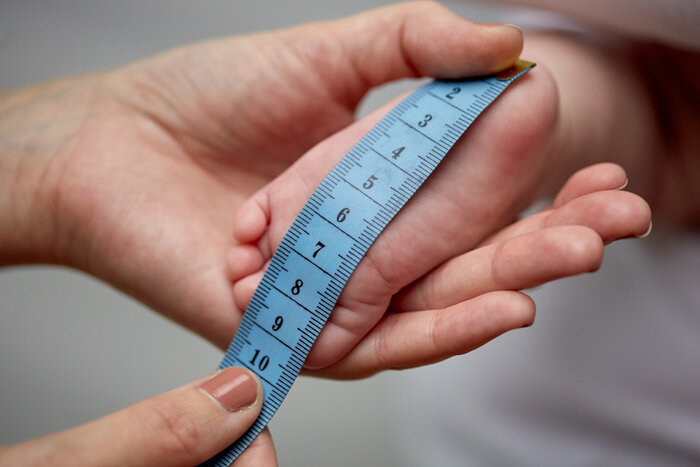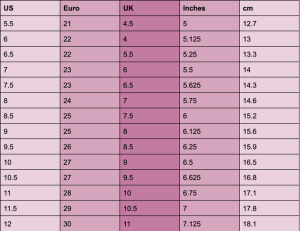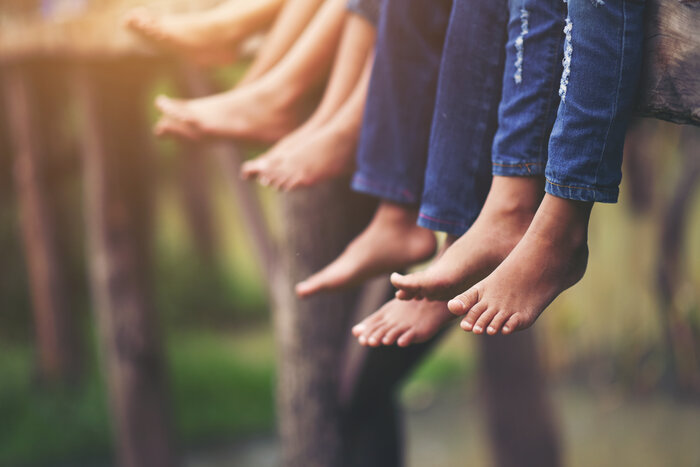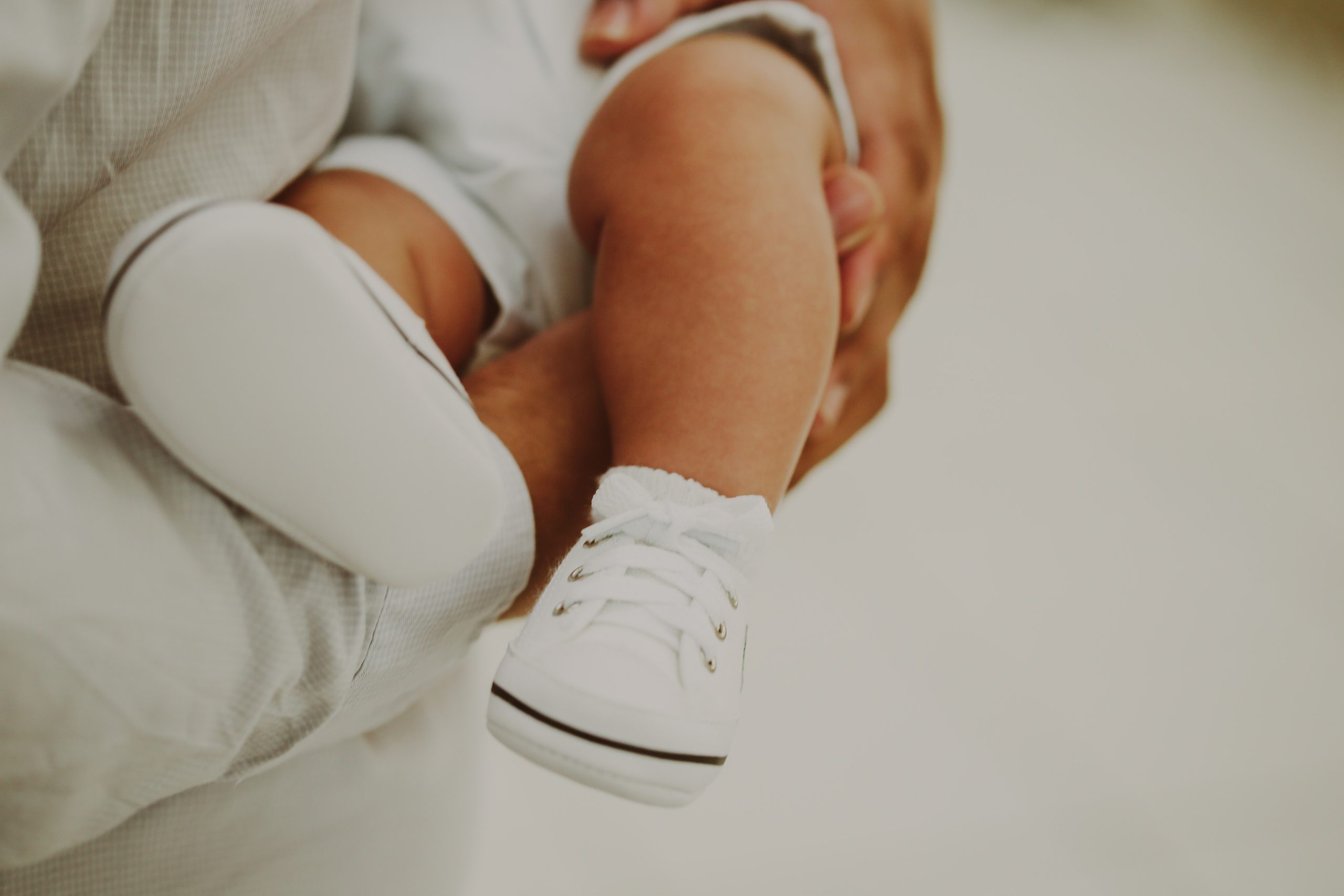A baby’s first steps are one of the big milestones that you will remember forever. This is the indicator that a trip to the shoe store is needed for their (very special) first pair of shoes.
But busy mums and dads don’t always have time for long trips to get their kids correctly fitted shoes. Furthermore, kids’ feet grow so quickly that it can be hard to keep up with the growth. Measuring your kid’s feet at home can give you their accurate shoe size, so you can buy shoes without them, or even online, saving busy parents a lot of time.
Your kid’s feet will grow extremely quickly, and it’s important their shoes aren’t too snug, or too loose as both can lead to problems. Here are conversion charts to measure your kid’s shoe size, and easy at-home methods of measuring your kid’s feet.

Baby Shoe Size Chart (0-12 Months)

Toddler/Infant Shoe Size Chart (1-5 Years)

Kids Shoe Size Chart (6-10 Years)

How To Measure My Kid’s Shoe Size At Home
There are some very easy ways to measure your kid’s feet at home, if you don’t have time to go to the shop to get them measured professionally. If you are in doubt, a professional is the right way to go. Shoes that are too small cause problems, and shoes that are too big risk falling off. Finding the middle ground is key, here are 3 easy ways to do so from your home.
1. The Tracing Method
This is one of the most common ways to measure your kid’s feet at home. It’s super easy, and accurate.
Equipment You Will Need:
- A blank piece of paper
- Ribbon
- A marker
- A ruler
- A pair of feet
The Method:
- Trace the feet. Get your child to stand on a piece of paper on top of a wooden floor or piece of cardboard. Ideally, they should stand against a wall for a straight back. Use the marker and trace the outline of their feet. Keep the marker upright for the best results.
- Measure the length. Your child can step away. Now measure the length from the heel to the tallest point on the big toe. Don’t forget to write the results down marked as the ‘length’ of the foot.
- Measure the width. Take the ribbon and wrap it around the broadest part of your child’s foot (the ball of the foot). Mark where the end of the ribbon touches, and measure the length of the ribbon. This is the ‘width’ of the foot.
- Find the size. Use the sizing guide above to work out the size of your child’s foot.
Remember Both Feet!
It’s not uncommon for your child’s feet to be slightly different sizes. Measure both feet to ensure that you get shoes that fit equally well.
Remember Both Feet!
It’s not uncommon for your child’s feet to be slightly different sizes. Measure both feet to ensure that you get shoes that fit equally well.
2. Printable Kid’s Shoe Size Chart
These shoe size charts are super handy. You can print them out, and get an instant measurement of your kid’s feet. You just need to ensure you print the guide accurately across the whole page.
Here’s What You’ll Need
- The printed guide – there are many available on the internet. Here is our favorite one.
- Scissors
- Tape
- A wall
- A pencil
- Shoelaces
- Your kid’s feet
The Printable Guide Method:
- Print the paper. Make sure the sizing of the print is accurate. Next, use the scissors to cut across the dotted line. Tape the chart to the floor, next to the wall for added stability.
- Measure the length. Place your child’s heel at the edge of the chart against the wall. Your child must be standing with their back against the wall, toes flat on the ground. Mark the tip of their longest toe to get the length of their foot.
- Measure the width. Take a shoelace and tie it around the widest part, then mark where the end touches the lace. Measure the distance of the shoelace that went around your child’s feet, and that’s their width.
- Work out their size. Take their measurements to a chart convertor and work out your kid’s size feet.
3. The Shoe Size Gauge
These gauges are sold online, or at shoe retailers, and are a simple way to get accurate measurements of your kid’s feet.
What You Need:
- The measuring device
- A pencil
- Paper
- A pair of feet
What You Will Do
- Stand up straight. Your kid should be facing forward with their back straight.
- Place the foot. Place your kid’s heel at the curved point of the device.
- Results. Write the numbers down of the length, where the tip of the big toe is. Make sure you measure both feet.
- Measure the width. Some measuring devices have a bar or tape measure that measures the width of your child’s foot. Use this to measure their width, or use the ribbon/shoelace method above to get their width.
- Find their size. Take these measurements and convert them to the right size shoe for your child

How Often Should My Kid’s Feet Be Measured?
Tiny feet grow the fastest. Between the ages of 2-6, your kid’s feet can grow up to a half size every 2-4 months. It’s recommended to measure your kid’s feet every 2 months and to buy new shoes every 2-3 months.
After your kid turns 4 years old (it might seem far away but the day will come!), foot growth does slow down a bit. It’s recommended to slow down the measuring process to every 3-4 months, and to get new shoes every 4-6 months to keep up with their feet changes.
This may seem a lot, but getting the right shoes for your kids makes sure they can take their first steps, and then walk, run and jump safely.
What If My Kid’s Size Feet Are In Between Sizes?
It’s always recommended to go with the larger foot if your child’s feet are in-between shoe sizes. No feet will be the exact same size, so don’t be alarmed if there is a small difference in size.
Choosing the larger size can prevent foot deformities such as bunions, or ingrowing toenails, which are caused by having shoes that don’t fit too properly.
Tips On Shoe Buying For Babies
Before your newborn begins to walk, there is no need for supportive, sturdy shoes. Socks, booties, or baby shoes are best (but being barefoot is ideal as this helps your child build coordination and strength in their legs and feet).
But once they take their first steps, supportive shoes are the way to go. Here are some tips on shoe buying for babies.
- Opt for breathable and lightweight shoes. Comfort is crucial, hard-soled shoes aren’t ideal as they aren’t the most comfortable or lightweight option.
- Soft soles are important. One way to test this is to bend the soles themselves. If they bend and stretch easily, they will provide support for your baby. If not, don’t buy them.
- Shop in the afternoon. Baby feet tend to swell in the day, so shopping in the afternoon means you will get the most accurately fitted shoe.
- Use the pinkie method to check the shoe fits. Try to place the pinky in between your baby’s heel and the back of the shoe while they stand. If you cannot or it feels tight, the shoe is too small.
Tips On Shoe Buying For Infants and Toddlers
- Don’t forget socks (unless you are shopping for sandals!). Make sure you try the shoes on with the socks so you can check the shoe fits perfectly. You may need to size up if you have thicker socks for the winter, to ensure the shoe doesn’t squish your kid’s feet.
- Always choose support over fashion. Your toddler is likely to start running, jumping, and experimenting with how to use their feet. Pointy shoes, high heels, or heavy-soled shoes won’t give them the support they need, no matter how in-fashion these shoes are.
- Velcro is the best option, over laces. You can teach your child how to put their shoes on and give them independence from a young age. Tying shoelaces will come later on.

Tips On Shoe Buying For Older Kids
- Make your kid strut or catwalk around the shop. Let them feel how the shoe fits and see if it is comfortable for them. They are likely to notice by this age whether it’s comfortable, too big, or too small. You can also see if it slips off your child’s feet, indicating it is too big.
- Use your thumbs to check if the shoe is the right size. Try and fit your thumb between the heel and the back of the shoe, it should fit snugly but not too tightly. Then place your thumb at the top of their shoe. There should be a thumb’s width between their big toe and the end of the shoe.
- Don’t buy shoes that are too big, even if you are on a budget. Your child needs supportive shoes that won’t come off unexpectedly, and as their feet aren’t growing as quickly you can be assured these shoes will last some time.
Still Unsure About Sizing Your Kid’s Feet?
If you are still concerned about measuring your kid’s feet at home remember to always ask a professional for their expert opinion. These people are found in kids’ shoe stores and are there to guide you through the measurement process.
Your Kid’s Feet Are Constantly Growing. Don’t Leave It To The Last Minute To Get Them Right Size Shoes.
Being a parent brings plenty of challenges, and plenty of beautiful milestones you will remember for the rest of your life. Unlike choosing your child’s diapers, there are many different sizes of shoes you can pick from, and as little as half an inch can affect whether the shoe is fitted well or not.
Don’t leave it to the last minute, measure your child’s feet regularly and make sure they have the correct shoes that will support them in their adventures.







